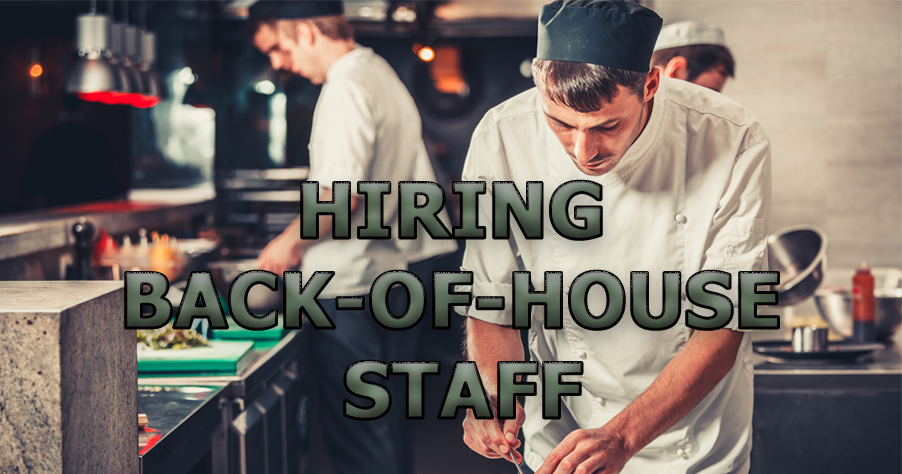
Like most leaders in business, you want to find the best talent to represent your brand. In order to identify the best employees for your establishment, you must understand what to look for in each individual hire. Hiring for your back-of-the house is equally as important as hiring for your front-of-house. Having a clear understanding of titles, skill sets, and responsibilities will help you match the right talent with your back-of-house needs. Read on to find out what each back-of-house employee should bring to your kitchen.
Note:Job summaries are open to interpretation by owner depending on unique needs of each establishment. There may be slight differences in responsibilities between casual and fine dining restaurants.
Prep Cook
Overview
The prep cook is the person who prepares for the dishes that are to be served. Though they typically don’t cook, they are a great asset to the chef, or other back of house staff when working to get order ready. Prep cooks handle the majority of preparation for the menu items. Your prep cook may be expected to be one of the first back of house staff members in the kitchen as ingredients must be pre-prepared in order for cooking to take place.
Responsibility Breakdown
- Consistently, safely and efficiently cut and chop foods
- Wash, weigh, and mixing ingredients
- Listen to and understand exact orders from the chefs
Helpful Traits
- Strong Listening skills
- Stamina
- Works well under pressure
Line Cook
Overview
Your line cook cooks on the line, which includes using the fryers, ovens, grills and other commercial cooking equipment. Because the prep cook has already prepared any chopped vegetables, sauces or other pre-cooked items, the line cook can began prepare the actual meal using these prepped items. Occasionally, an establishment will have hierarchy levels of line cooks, broken up into the fry cook, sauté cook, and more.
Responsibility Breakdown
- Follow a provided recipe and quality standard set by sous chef or executive chef
- Prepare a variety of food items using grill, ovens, range, broilers, and fryer
- Makes sure that all food products are properly portioned
- May unload delivery trucks and store inventory in its proper place
Helpful Traits
- 4 or more years of kitchen cooking experience
- Good communication and analytical skills
- Ability to work quickly and efficiently
Sous Chef
Overview
In the commercial kitchen hierarchy, the sous chef is second-in-command below the executive chef. The sous chef is there to ensure that the line cook executes the vision properly and is sometimes called the “under-the-chef” in the kitchen. Many times a junior chef can fill this role as well. Of course the sous chef will have a diversified role (and hence a very large responsibility), however, the main objective of this employee will be to assist the head chef by ensuring quality food is produced.
Responsibility Breakdown
- Work with executive chef to develop new dishes and menu items
- Ensure cooking equipment is in safe, working order for kitchen staff
- Train new talent in the kitchen to ensure food service quality objectives are accomplished
- Organizes staff schedules and work flow of kitchen
- Ensure food safety standards are from food preparation to table
Helpful Traits
- Highly organized
- Full knowledge of food products and equipment
- Basic computer skills
- Through understanding of food and labor costs
Executive Chef
Overview
An executive chef is usually someone who has worked his or her way up the kitchen hierarchy. He or she is responsible for managing the kitchen and all of the staff. Duties span from overseeing the daily operations of a kitchen to developing new recipes, business, and administrative tasks.
Responsibility Breakdown
- Create menu items
- Determine the best presentation of food
- Inspects kitchen equipment for sanitation
- Ensure freshness of food
- Make purchase orders
Helpful Traits
- Strong leadership skills
- Highly organized
- Experience managing others
Busser
Overview
The busser of your establishment will work between your front-of-house and your back-of-house. Bussers ensure that tables are completely cleared so that new guests can be seated. Depending on the establishment style, budget and other factors- certain tasks of a busser may be performed by a staff member such as the waiter or a host.
Responsibility Breakdown
- Makes sure that tables, chairs and dining area is clean and sanitized
- Re-stocks small ware, flatware, and condiments
- Consistently maintains adequate supplies
- Bring clean dishes to cooks for meal presentation
- Clears, and replenishes salad bars and drink stations
Helpful Traits
- Ability to reach, kneel, and lift
- Works well with others
- Polite and friendly attitude
- Cleanliness
Dishwasher
Overview
The dishwasher does exactly what his or her title implies – washes dishes. Though this person may have other responsibilities, the core task is to ensure that dishes, cookware, food storage and smallwares are clean and sanitary before they are used.
Responsibility Breakdown
- Helps maintain clean kitchen work area
- Receive and store supplies such as plates, utensils, and place mats
- May empty back of house garbage and waste
Helpful Traits
- Ability to work quickly
- Attention to detail
- Team oriented
Hire Well and Thrive
With the right help on your team, you will not only benefit from running a successful establishment, but maintain successful employee relations will also be easier. Your back-of-the-house can run smoothly if you simply know what qualities, skill-set, and talent to look for in each role. Avoiding mistakes that can hold your kitchen back, such as hiring the wrong employees is a great way to see the fruits of your labor pay off.

